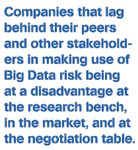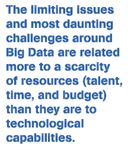Super-Size Me: Optimizing the Information Explosion
Options for using data have proliferated to the point of becoming overwhelming. So what opportunities does this information explosion present?
On both the clinical and commercial sides of the pharmaceutical business, the options for using data have proliferated to the point of becoming overwhelming. Everything is bigger, from the databases themselves, to the investment required, to the payoffs for getting it right.
The Walls Are Tumbling Down
Other sectors—namely the retail, consumer packaged goods, and financial industries—have been coping with Big Data for as long as a decade. So, why is it just now becoming topical in the pharmaceutical industry? There are two interrelated reasons.
First, the healthcare delivery system has traditionally been very fragmented, and information has not flowed freely across entities. Rather, each party has used its own data (or created data as a biproduct of automation), and there was no impetus to share it. However, with the rapid increase in usage of Electronic Medical Records (EMRs), which is the result of federal funding, the creation of Accountable Care Organizations (ACOs), and the rise of health information exchanges, those silos are breaking down. There is a drive to allow information systems to communicate with one another across all points in the delivery of care.
Second, there is a growing, almost insatiable, demand for information as healthcare becomes evidence-based. Every party in the system—from manufacturers, to payers, policymakers, to providers and patients—has much to gain from understanding what works and what doesn't. And that requires a comprehensive view that can only be gained from multiple data sources that, when amassed, become Big Data.
The Obama administration further reinforced the need for Big Data in its March 29 announcement of $200 million in funding for a "Big Data Research and Development Initiative," which seeks to improve our ability to extract knowledge and insights from large and complex collections of digital data. While the initiative is intended to address scientific discovery, environmental and biomedical research, education, and national security, healthcare clearly stands to benefit from such significant investment.
The new sources of information that are causing such a stir within the pharmaceutical industry include:
Electronic Medical Records. The data contained in these systems provide a detailed clinical picture within the site of care and contribute to an overall view of a patient's treatment pathway.
Social Media. Patients use social networking to, as the Pew Internet & American Life Project described it, "lend a hand, lend an ear, lend advice" to one another. "Listening in" on such public exchanges can provide rich insights into the patient or prescriber perspective.
Real-World Evidence. Privately funded and government-sponsored longitudinal studies produce a wealth of information on treatment practices, patient persistence and compliance, and health outcomes, which are increasingly required by payers.
Personalized Medicine. When, in the foreseeable future, an individual's genome can be mapped affordably, the amount of data—while staggering—will bring exponential value to medicine. It will be possible to go beyond understanding what works and what doesn't, to actually predicting what will work, person by person.
Track-and-Trace Systems. If the FDA succeeds in mandating that pharmaceutical companies install systems to track and trace their products, the systems would generate a data point every time a package "hits a node" on the distribution system.
When all of these elements are added to existing information sources—including secondary data, a company's own closed-loop marketing program, or other internal data—the Big Data challenge grows exponentially.
Big Value in Big Data
Underlying the interest in Big Data is the desire to gain a competitive advantage via speed to insight and faster, more effective decision-making. Companies that lag behind their peers and other stakeholders in making use of Big Data risk being at a disadvantage at the research bench, in the market, and at the negotiation table. It becomes obvious even through the following broad list of potential applications that no company could afford to be left behind in using Big Data, which can be used to:
» Uncover unmet needs
» Assess the feasibility of clinical trial designs and recruit trial subjects
» Demonstrate product value
» Conduct pharmacovigilance
» React more quickly to market changes via real-time market measurement and sophisticated KPIs
» Enhance commercial activities and enable more personalized messaging
» Deploy predictive capabilities rather than retrospective analytics

Ready or Not, Here It Comes
Like a kid in a candy store, the industry is looking at the new data sources and the insights they can offer as a tempting array of choices. But on what should they spend their dime? What is the best investment strategy? Which new sources will yield the greatest return? What might they miss if they head down one path too early?
This speaks to the need to not only understand what can be gained from each new source of information, but to also work backwards from an understanding of what it is a company wants to achieve. Just as "form follows function" in design, "data follows strategy" in business.
Questions also inevitably arise around a company's ability—from a technical, organizational, and intellectual standpoint—to extract the value from Big Data. But before they begin, organizations must consider collection, aggregation, integration, and presentation of the data. What technology investment is required to store and mine the data? What should be done in-house, versus by business partners? What skills and IP should a company safeguard as a competitive advantage?
Are We There Yet?
We contend that the necessary technology to deal with Big Data either exists today or is currently in development. And, since technology is always advancing and changing, it could be argued that a company's plans should be "technology agnostic." Consider the various layers of technology involved:
Collection, Aggregation, and Storage. The technology exists to collect, aggregate, and store massive amounts of structured and unstructured data. It requires a lot of "heavy lifting," but it can be—and is—done. IMS's technology infrastructure is a case in point: We routinely process 38 billion transactions each year, which are collected from nearly 700,000 reporting sites worldwide. Few pharmaceutical companies are likely able to process data on this scale cost-effectively on their own, simply because of the upfront investment required.
Even so, we are seeing advances today and on the five-year horizon that will short-circuit some of the work and time required to code and extract data. In the near-term, there is a methodology being tested by Internet search companies that may be applicable to industry databases. Essentially, it uses algorithms to reduce the amount of data that needs to be restructured when it is loaded by spotting what has changed. Further into the future, we may be able to do away with having to retrieve data from storage when we need it; everything could be immediately accessible in memory on solid-state disks.
Analytics. The tools that can support analytics across Big Data are becoming available. Software manufacturers and service providers are investing billions in their development, although we certainly are not there yet when it comes to being able to analyze every aspect of Big Data simultaneously. One scientist captured it well. While referring to his computer, he lamented, "The cure for cancer is in that box, but we can't get it out."
One exciting area of progress is in predictive analytics (as opposed to retrospective analytics). This will be invaluable in marketing (being able to predict customer behavior), outcomes research, and potentially for payment and reimbursement schemas based on historical behaviors.
Reporting. Great strides are being made in data visualizations, and mobile business intelligence is quickly emerging as a capability. Data visualization tools can be utilized to enable non-data programmers to analyze the data in real-time. More comprehensive mobile reporting is on the way, and companies ought to be establishing their mobile strategy now.
So, the necessary technology is coming along, and, in fact, is already ahead of most firms' ability to adopt it. The limiting issues and most daunting challenges around Big Data are related more to a scarcity of resources (talent, time, and budget) than they are to technological capabilities.
The Human Element
In the continuum that stretches from acquiring Big Data on the one end to reporting findings from it on the other, what should pharma keep "close to the vest?" What functions/responsibilities ought to remain in-house?
It likely will be impractical for pharma to be in the business of acquiring Big Data, given the vast number of sources and privacy rules associated with this. At the same time, it my be highly inefficient for pharma to process and deliver the data, as cloud-based computing and storage has made owning storage and processing impractical for most entities at the scale the cloud affords.

The IT infrastructure for dealing with Big Data will be in private and public clouds and maintained by someone else. Routine analytics will be outsourced. Reporting will be outsourced. What companies must have, though, will be people responsible for:
» Setting the company's technology strategy and designing the architecture for internal systems
» Implementing and overseeing data governance
» Managing the company's many business partners
» Designing or approving new analytical algorithms and approaches
» Understanding the insights that analytics provide and using them for applications that provide strategic competitive advantage
» Setting key performance indicators
How Should Companies Proceed?
As a first step, firms must recognize that partnerships with third-party providers will be required, given the considerable costs involved. Data aggregators, cloud solution providers, and analytical software companies all will play some role in the necessary capabilities. The fast-changing environment requires being open to new and evolving data and technology solutions.
Second, companies would do well to create a Data Governance Council—a cross-functional team with representatives from IT, business strategy, HEOR, clinical development, market research, commercial analytics, legal, and compliance. This team should be charged with developing an enterprise-wide information strategy that covers:
» The types of data that are needed
» Where the data will come from
» What level of quality is needed (this will differ by application)
» How quality will be maintained
» How the data will need to be structured
Allowing separate research, brand, marketing, and managed markets groups to acquire data separately will sub-optimize the company's path forward. Data acquisitions should be considered for their potential appeal to multiple users and ensure that companies gain the maximum value from their investment; the cost of Big Data will preclude functions from buying data without regard for how it might be used elsewhere. Indeed, the lines between clinical and commercial applications of data are already becoming blurred.
Each company will obviously have to find its own "path to enlightenment" with Big Data, but it will almost certainly involve a new way of working. This will be apparent in what remains proprietary IP versus what is outsourced, as well as through a new level of collaboration across the enterprise on data purchases, data management practices, and data uses.
Don Ragas is Chief Architect, Global Operations at IMS Health. He can be reached at dragas@us.imshealth.com

Is Artificial Intelligence a ‘Product’? Products Liability Implications for AI-Based Products
April 10th 2025As the physical products we use evolve to become increasingly complex, traditional products liability frameworks may not always fit to provide remedies for harm that can result from using novel product types.